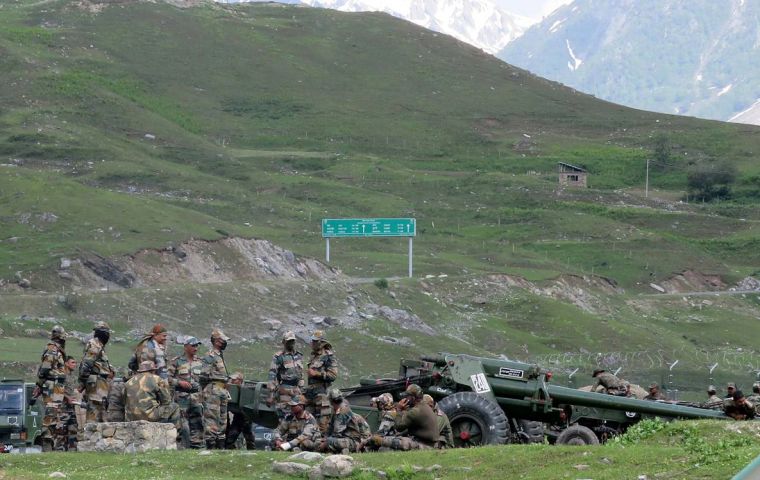MercoPress. South Atlantic News Agency
China and India fight in disputed Himalayan area; New Delhi admits 20 dead soldiers
 The Indian army said a number of its troops “were critically injured in the line of duty”. The injured soldiers were also “exposed to sub-zero temperatures in the high altitude terrain ”
The Indian army said a number of its troops “were critically injured in the line of duty”. The injured soldiers were also “exposed to sub-zero temperatures in the high altitude terrain ” China and India have accused each other of provoking fighting in which at least 20 Indian soldiers were killed in a disputed Himalayan area. The Indian army said that both sides suffered casualties, but there has been no word on numbers from China yet.
Tuesday's battle was reportedly fought with rocks and clubs. However, no shots were fired.
The Indian army said a number of its troops “were critically injured in the line of duty”. The statement goes on to note that the injured soldiers were also “exposed to sub-zero temperatures in the high altitude terrain ”.
Monday's confrontation in the Ladakh region was the first deadly clash in the border area in at least 45 years.
India said China had tried to “unilaterally change the status quo”. Beijing accused Indian troops of “attacking Chinese personnel”. The two armies later held talks to try to defuse tensions.
Early on Tuesday, the Indian army said three of its soldiers had died in a clash in Ladakh, in the disputed Kashmir region. It later said that “17 Indian troops who were critically injured in the line of duty” and died from their injuries, taking the “total that were killed in action to 20”.
Both sides insist no bullet has been fired in four decades, and the Indian army said on Tuesday that “no shots were fired” in this latest skirmish.
How a clash that did not involve an exchange of fire could prove so lethal is unclear, but local media outlets reported that the Indian soldiers had been “beaten to death”.
India's external affairs ministry accused China of breaking an agreement struck the previous week to respect the Line of Actual Control (LAC).
Foreign ministry spokesman Anurag Srivastava said the clash arose from “an attempt by the Chinese side to unilaterally change the status quo” on the border.
China did not confirm the number of casualties, but accused India in turn of crossing the border onto the Chinese side.
“The arrogance and recklessness of the Indian side is the main reason for the consistent tensions along China-India borders,” read an editorial in the Chinese state-run Global Times on Wednesday.
The United Nations has urged both sides “to exercise maximum restraint”.
“We take positive note of reports that the two countries have engaged to de-escalate the situation,” UN associate spokesperson Eri Kaneko said.
A US State Department spokesman, meanwhile, said it was “closely monitoring” the situation and that the US supports a peaceful resolution.
The LAC is poorly demarcated. The presence of rivers, lakes and snowcaps means the line can shift. The soldiers either side - representing two of the world's largest armies - come face-to-face at many points.
But there have been tense confrontations along the border in recent weeks.
India has accused China of sending thousands of troops into Ladakh's Galwan valley and says China occupies 38,000sq km of its territory. Several rounds of talks in the last three decades have failed to resolve the boundary disputes.
The two countries have fought only one war so far, in 1962, when India suffered a humiliating defeat.
In May, dozens of Indian and Chinese soldiers exchanged physical blows on the border in the north-eastern state of Sikkim. And in 2017, the two countries clashed in the region after China tried to extend a border road through a disputed plateau.
There are several reasons why tensions are rising now - but competing strategic goals lie at the root, and both sides blame each other.
India has built a new road in what experts say is the most remote and vulnerable area along the LAC in Ladakh. And India's decision to ramp up infrastructure seems to have infuriated Beijing.
The road could boost Delhi's capability to move men and materiel rapidly in case of a conflict. India also disputes part of Kashmir - an ethnically diverse Himalayan region covering about 140,000sq km - with Pakistan.




Top Comments
Disclaimer & comment rulesCommenting for this story is now closed.
If you have a Facebook account, become a fan and comment on our Facebook Page!